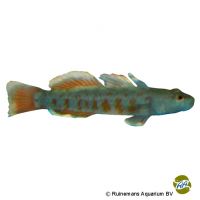Zhou's Scarlet Goby (Rhinogobius zhoui)
| Zhou's Scarlet Goby Rhinogobius zhoui | |
|---|---|
| Name | Zhou's Scarlet Goby |
| Name Lat. | Rhinogobius zhoui |
| Family | Gobies |
| Family lat. | Gobiidae |
| Order | Gobies |
| Order lat. | Gobiiformes |
| Origin | Southern China |
| Habitat | Mountain streams |
| Diet | Carnivore |
| pH | 6.5-7.5 |
| Behavior | Peaceful |
| Keeping | Pair, group |
| Care Level | Moderate |
| Reproduction | Substrate spawner |
| Breeding | Difficult |
| Life Span | 3-6 years |
| Protection | No |
| Metric Units | |
| Size | 4 cm |
| Temperature | 19-24 °C |
| Hardness | 5-12 °dH |
| Aquarium | ~ 60 l |
| US Units | |
| Size | 1.6" |
| Temperature | 66-75 °F |
| Hardness | 89-214 ppm |
| Aquarium | ~ 15 gal |
Distribution and habitat
The flame gobies are found exclusively (endemically) in Guangdong Province in southern China. There they inhabit some small, oxygen-rich streams in the Lianhuna Mountains, where they live in shallow water with sandy bottoms among stones, foliage and aquatic plants.
Maintenance
The aquarium should have partly dense planting and be structured with round river pebbles, flat stones and caves (e.g. clay tubes). A fine-grained substrate of round gravel, which can be covered with some foliage (sea almond tree, oak) and a moderate current is ideal. 
No ammonia, ammonium and nitrite should be detectable, the nitrate value should not exceed 100 mg/l. To ensure water quality and oxygen content, a filter and heater adapted to the size of the aquarium is required, as well as lighting for the species-appropriate day-night rhythm of the animals.
Diet
In nature they feed mainly on insects, small crustaceans and plankton. The food supply consists of live or frozen cyclops, daphnia, bosmids, artemia, red mosquito larvae, etc. After habituation, sinking, protein-rich dry food (granules, pellets, flakes) is also usually well accepted, but should not be the main component of the diet.
They are slow eaters. It is recommended to feed small portions several times a day. Only as much should be fed as is eaten within a few minutes. A regular and varied diet promotes health and increases resistance.
Behaviour and compatibility
They occasionally act somewhat rough with other fish and males are intra-species quarrelsome. They should be kept in pairs or in a small group where aggression is better distributed. Keeping a group, two males with several females, is only recommended in a larger and richly structured tank. They can be well socialized with fish that reside in the upper water region
Basically, only compatible fish species with similar demands on water condition and water temperature should be socialized.
Sex dimorphism
Adult males are much more colorful than females and have longer unpaired fins, with thick, pale, bluish to whitish fringes.
Reproduction and breeding
They are cave breeders. The eggs are usually laid on the ceiling of a cave or crevice and guarded by the male. The larvae hatch after 3-4 days and float in the water. They begin to ingest minute food (rotifers) immediately after their yolk sac is depleted. After 9-12 days, their pelagic development is complete and the fry swim freely.
The fry must be fed several times a day with special rearing food (Artemia nauplii, microworms). In community tanks breeding is hardly possible, because the fry are easy prey.
Important
The gobies like to sit on flat or round stones in the current. They originate from cool mountain streams and accordingly higher temperatures are not tolerated in the long run. They can change their coloration very quickly due to their mood, e.g. during territorial disputes.
The well-being of the fish should be checked regularly. The temperature should be checked daily, the pH value, hardness and nitrate value at least every 14 days. Regular partial water changes are recommended, even if the contaminant level has not yet reached the upper limit. Sudden changes in water quality should be avoided. Newly introduced fish must be accustomed slowly to the water in the aquarium.
Further literature can be found in your pet store.
References
Text: Werner Winter; Image: Ruinemans Aquarium B.V.
Source: BMEL (1998): Tierschutzgutachten - Haltung von Zierfischen (Süßwasser); ENGELMANN (2005): Zootierhaltung - Tiere in menschlicher Obhut: Fische, Verlag Harri Deutsch
- Gemäß § 21 Abs. 5 Tierschutzgesetz idgF
